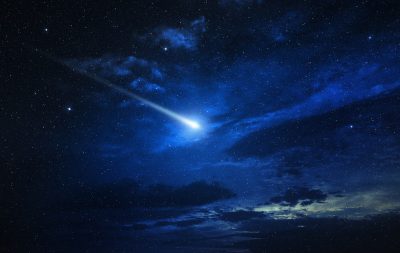
ST. GEORGE — Stargazers with their heads turned to watch April’s solar eclipse could be treated to a rare celestial sighting: Comet 12P/Pons-Brooks, which hasn’t been seen from Earth in over 70 years.

Approximately the size of Mount Everest, Comet 12P/Pons-Brooks was nicknamed the “devil comet” for its unusual horned features and peculiar green color.
Astronomers say the comet was likely to reach a brightness of 5th-magnitude at the end of March, bringing it into visibility by the naked eye. While the comet will move into daylight hours on Tuesday, April 2, those in the Northern Hemisphere using a telescope or pair of binoculars could catch sight of the “devil comet” near the western horizon at dusk.
The comet will make its closest pass by Earth in the days leading up to the solar eclipse on April 8, when it will reportedly be about 25 degrees away from the eclipsed sun. During mid-eclipse, those using binoculars or a telescope have the potential to see the comet, according to an article posted on astronomy.com. Jupiter can serve as a guide for finding the comet, which will reportedly lie about 6 degrees west of the gas giant.
Keep in mind, due to the comet’s unpredictable brightness and possible weather conditions, there is no guarantee that the comet will be viewable. Those in the direct path of the eclipse are likely to have the best chance at observing this unique duo.
Though not as well-known as Halley’s Comet, Comet 12P/Pons-Brooks is nearly as elusive. Halley’s Comet makes a flyby every 74 years, while the “devil comet” appears once every 71 years, which means that for many, these rare appearances serve as once-in-a-lifetime events.
At more than 21 miles in diameter, Comet 12P/Pons-Brooks is also known as a cryovolcanic comet for its volcano-like eruptions of gas, ice and dust, and is known to have sudden flares of brightness.
Named after the French astronomer Jean-Louis Pons, who discovered the comet during its first flyby during the 18th century, and William Robert Brooke who caught the next appearance in 1833, this comet was seen as far back as the 14th century, according to an article posted on Phys.org.
On April 21, the comet will arrive at perihelion, a point when the comet is closest to the sun, before it sails on to become an object in the sky for viewers in the Southern Hemisphere.
Once it disappears from view, it will not make another appearance until 2095.
The comet’s flyby arrived amid eclipse season, which kicked off with a lunar eclipse on March 24, followed by the total solar eclipse on April 8.
An eclipse season is a 30-35 day period in which at least two, sometimes three, eclipses occur. Typically, there are two eclipses in one eclipse season, and two eclipse seasons in one calendar year, according to Earth-Sky.
Copyright St. George News, SaintGeorgeUtah.com LLC, 2024, all rights reserved.